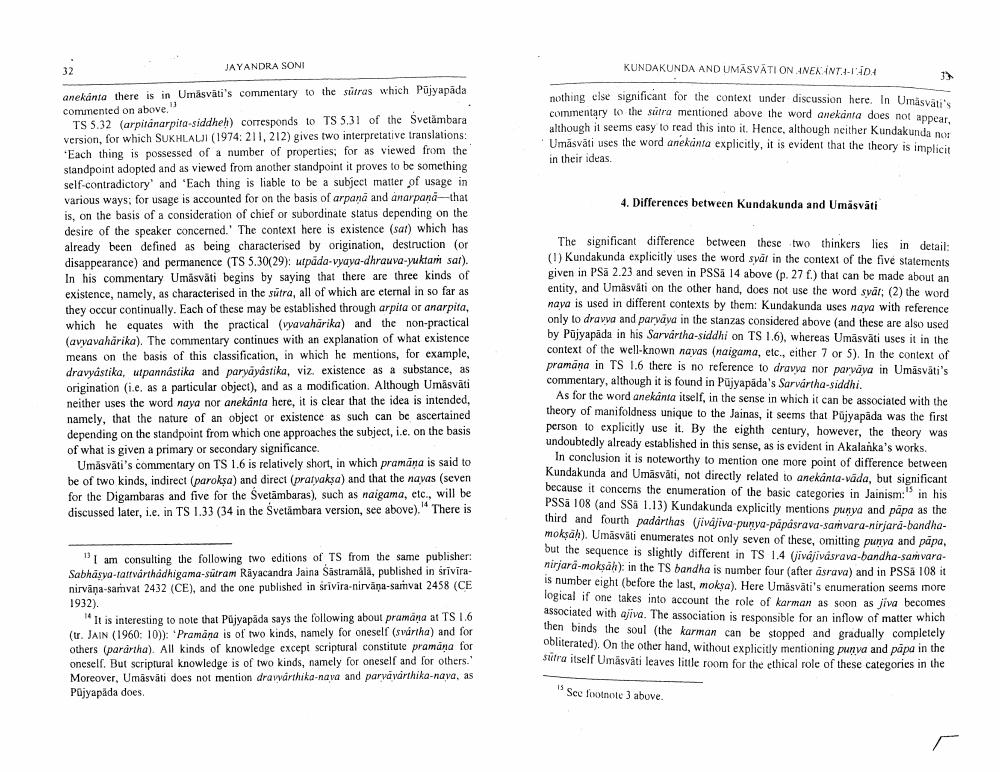________________
JAYANDRA SONI
KUNDAKUNDA AND UMÄSVATION ANEXANT-LADA
nothing else significant for the context under discussion here. In Umasväti's commentary to the sülra mentioned above the word anekanta does not appear. although it seems easy to read this into it. Hence, although neither Kundakunda nos Umásvāti uses the word anekanta explicitly, it is evident that the theory is implicit in their ideas
4. Differences between Kundakunda and Umásvati
anekanta there is in Umasväti's commentary to the sutras which Pujyapada commented on above."
TS 5.32 (arpitanarpita-siddheh) corresponds to TS 5.31 of the Svetambara version, for which SUKHLALI (1974: 211, 212) gives two interpretative translations: *Each thing is possessed of a number of properties for as viewed from the standpoint adopted and as viewed from another standpoint it proves to be something self-contradictory' and 'Each thing is liable to be a subject matter of usage in various ways, for usage is accounted for on the basis of arpana and anarpana-that is, on the basis of a consideration of chief or subordinate status depending on the desire of the speaker concerned.' The context here is existence (sat) which has already been defined as being characterised by origination, destruction or disappearance) and permanence (TS 5.30(29): utpada-vyaya-dhrauva-yuktam sar). In his commentary Umásvati begins by saying that there are three kinds of existence, namely, as characterised in the sutra, all of which are eternal in so far as they occur continually. Each of these may be established through arpita or anarpita, which he equates with the practical (vyavahárika) and the non-practical (avvavahărika). The commentary continues with an explanation of what existence means on the basis of this classification, in which he mentions, for example, dravyasrika, utpannàstika and paryayastika, viz. existence as a substance, as origination (ie, as a particular object), and as a modification. Although Umasväti neither uses the word naya nor anekanta here, it is clear that the idea is intended, namely, that the nature of an object or existence as such can be ascertained depending on the standpoint from which one approaches the subject, i.e. on the basis of what is given a primary or secondary significance.
Umäsväti's commentary on TS 1.6 is relatively short, in which pramāna is said to be of two kinds, indirect (parokşa) and direct (pratyaksa) and that the nawas (seven for the Digambaras and five for the Svetambaras), such as naigama, etc., will be discussed later, i.e. in TS 1.33 (34 in the Svetambara version, see above)." There is
The significant difference between these two thinkers lies in detail: (1) Kundakunda explicitly uses the word spät in the context of the five statements given in Psa 2.23 and seven in PSS 14 above (p. 27 f.) that can be made about an entity, and Umásváti on the other hand, does not use the word svār; (2) the word nava is used in different contexts by them: Kundakunda uses naya with reference only to dravva and paryaya in the stanzas considered above and these are also used by Pujyapāda in his Sarvartha-siddhi on TS 1.6), whereas Umasvati uses it in the context of the well-known navas (naigama, etc., either 7 or 5). In the context of pramana in TS 1.6 there is no reference to dravva nor parvava in Umasväti's commentary, although it is found in Pujyapada's Sarvártha-siddhi.
As for the word anekanta itself in the sense in which it can be associated with the theory of manifoldness unique to the Jainas, it seems that Pujyapada was the first person to explicitly use it. By the eighth century, however, the theory was undoubtedly already established in this sense, as is evident in Akalanka's works
In conclusion it is noteworthy to mention one more point of difference between Kundakunda and Umäsväti, not directly related to anekanta-vāda, but significant because it concems the enumeration of the basic categories in Jainism:" in his PSS 108 (and SS 1.13) Kundakunda explicitly mentions punya and papa as the third and fourth padarthas (ivasiva-punya-papásrava-samvara-nirjara-bandhemoksah). Umasväti enumerates not only seven of these, omitting punya and papa, but the sequence is slightly different in TS 1.4 (jivajivásrava-bandha-samvaranirjara-moksáh): in the TS bandha is number four (after asrava) and in PSS 108 it is number eight before the last, moksa). Here Umasväti's enumeration seems more logical if one takes into account the role of karman as soon as jiva becomes associated with ajiva. The association is responsible for an inflow of matter which then binds the soul (the karman can be stopped and gradually completely obliterated). On the other hand, without explicitly mentioning punya and papa in the sutra itself Umásváti leaves little room for the ethical role of these categories in the
"I am consulting the following two editions of TS from the same publisher: Sabhasyo-larvárthadhigama-sūtram Rayacandra Jaina Sastramala, published in sriviranirvana-samvat 2432 (CE), and the one published in srivira nirva-samvat 2458 (CE 1932).
"It is interesting to note that Pujyapada says the following about pramana at TS 1.6 (tr. JAIN (1960: 10)): "Pramana is of two kinds, namely for oneself (svártha) and for others (parartha). All kinds of knowledge except scriptural constitute pramana for oneself. But scriptural knowledge is of two kinds, namely for oneself and for others. Moreover, Umäsväti does not mention dravarthika nava and parvavarthika-nava, as Pojyapada does.
See footnote 3 above.




